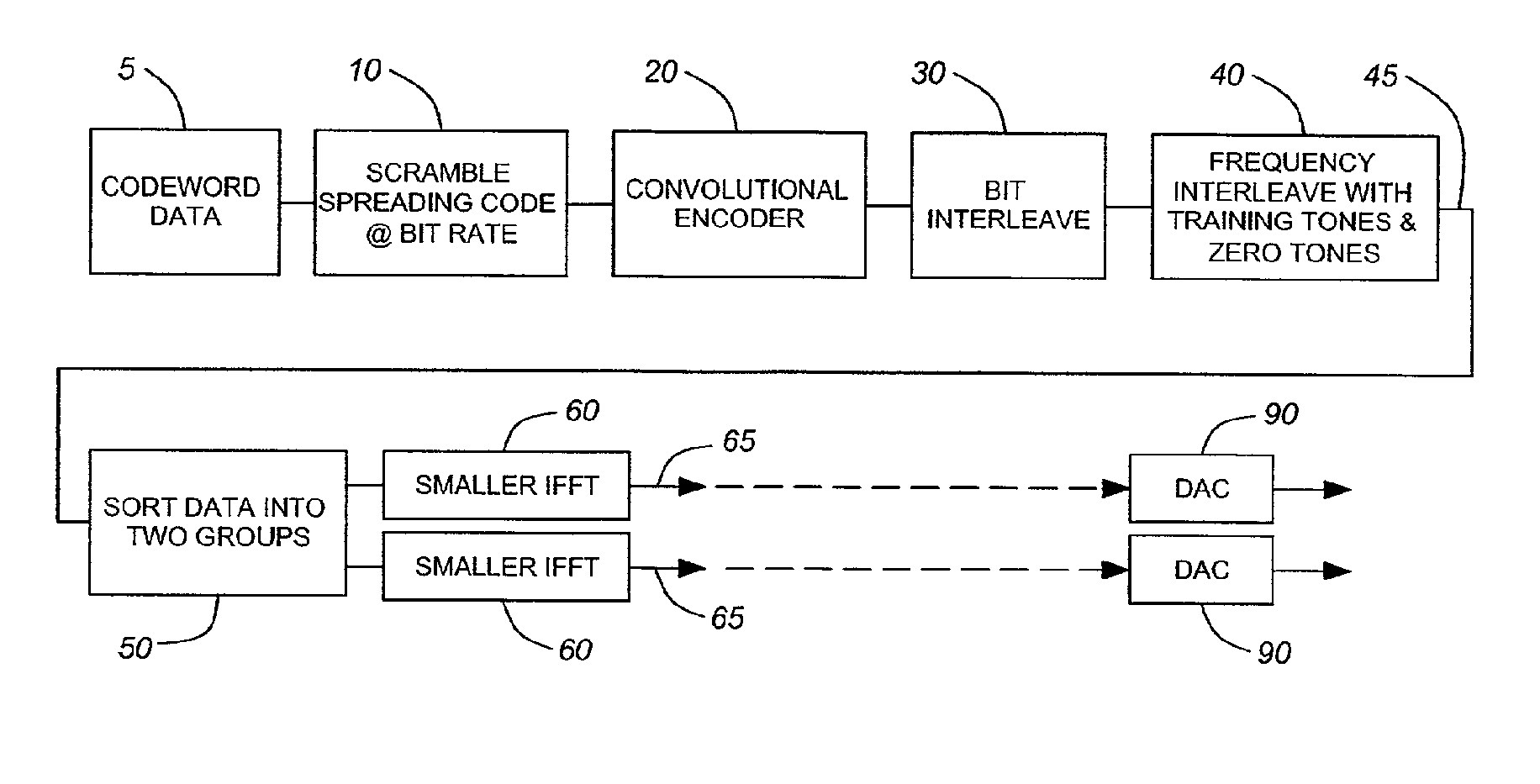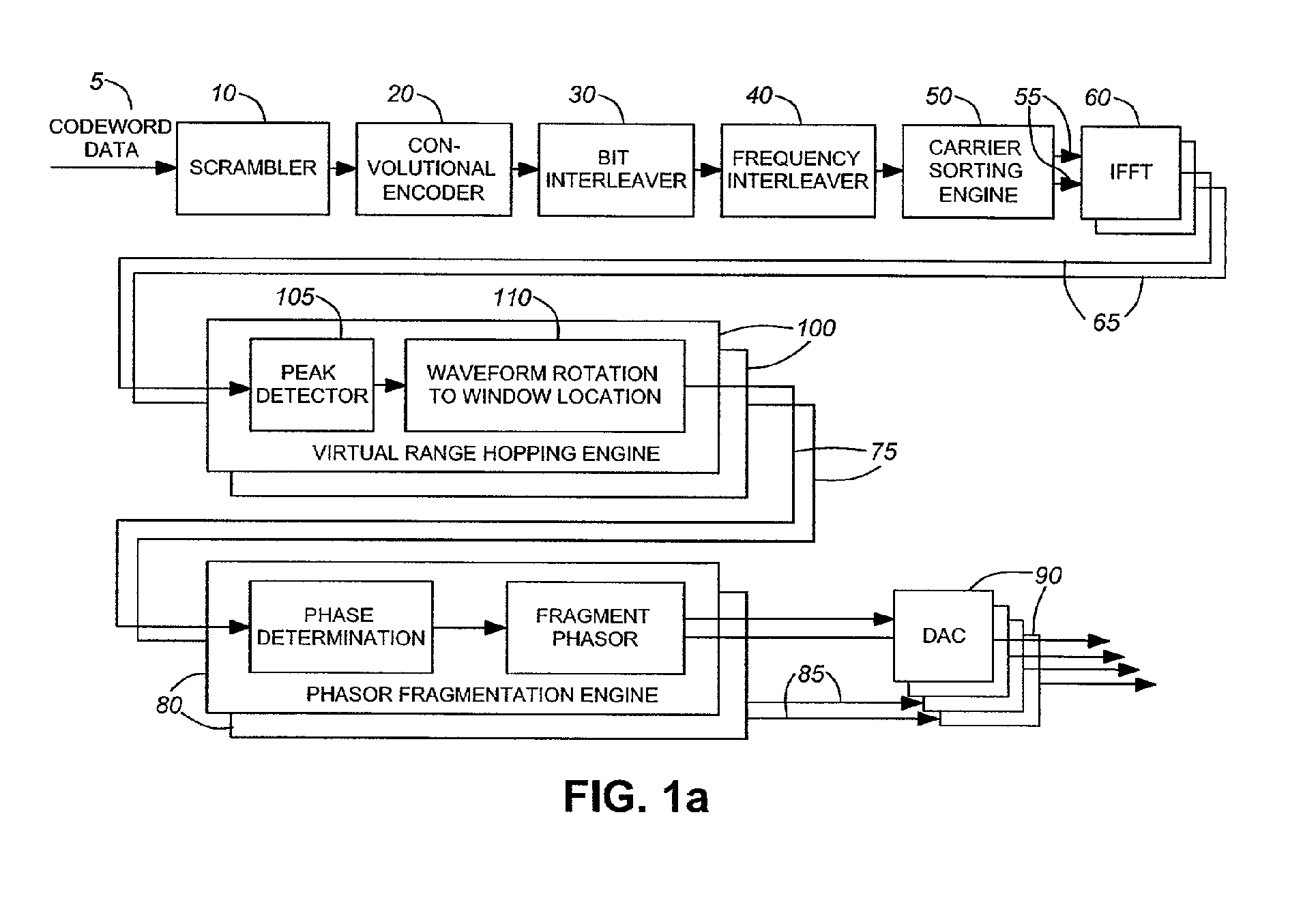Computational circuits and methods for processing modulated signals having non-constant envelopes
a computation circuit and modulation signal technology, applied in multiplex communication, orthogonal multiplex, baseband system details, etc., can solve the problem of relative high peak-to-average power ratio, achieve low peak-to-average power ratio, improve the performance of the circuit used for digitally generating modulation signals, and reduce peak-to-average power ratio
- Summary
- Abstract
- Description
- Claims
- Application Information
AI Technical Summary
Benefits of technology
Problems solved by technology
Method used
Image
Examples
first embodiment
[0043] a phasor fragmentation engine is illustrated by FIGS. 5(a) and (b) and 6. FIGS. 5(a) and (b) illustrate two vector diagrams of a predetermined phasor V (i.e. a modulation signal), each at a different time ((a) and (b)), showing representations of the predetermined phasor V as the sum of two equal amplitude fragment phasors (K1 V−K2) which are continuously rotated to track the time varying amplitude and phase of the desired phasor. Each of the two fragment phasors has its amplitude continuously adjusted to a predetermined proportion of the predetermined signal's amplitude variation about its mean. As such, the fragment phasors' peak-to-average ratios are reduced to the predetermined proportion.
[0044] As shown in FIG. 5, the magnitude of the two fragment phasors is calculated as (K1 V−K2) and, because it is dependent on the value of V, the magnitude varies and is continuously adjusted as V changes. FIG. 6 illustrates the computational steps performed by a digital signal process...
second embodiment
[0054] a phasor fragmentation engine in accordance with another aspect of the invention is illustrated by FIGS. 7(a) and (b). As shown in these figures (wherein (a) represents one point in time and (b) represents another point in time) two equal, fixed magnitude phasors (Vmax / 2) are continuously rotated in order to track the time varying magnitude and phase of the predetermined (modulation) signal V. The magnitude of the two fragment phasors is dependent on the maximum magnitude of V over the period of the sample and is, therefore, constant.
[0055] The amplitude for the two equal magnitude fragment phasors is:
VPHASOR=VMAX / 2
[0056] To the phase at each time sample, this phasor fragmentation engine adds and subtracts .phi. whereby:
Φ=cos−1(V / VMAX)
[0057] In this embodiment, because the two fragment phasors are of constant magnitude, low dynamic range (low compression point) up-converters can be used. Further, highly efficient S Class power amplifiers can be used, providing no-backoff ...
third embodiment
[0058] a phasor fragmentation engine in accordance with another aspect of the invention is illustrated by FIGS. 8(a) and (b). As shown in these figures (wherein (a) represents one point in time and (b) represents another point in time), three equal, fixed magnitude phasors (Vmax / 3) are continuously rotated in order to track the time varying magnitude and phase of the predetermined (modulation) signal V. The magnitude of the three fragment phasors is dependent on the maximum magnitude of V over the period of the sample and is, therefore, constant. This embodiment of a phasor fragmentation engine makes use of the property of isosceles triangles as well as that of coherent and incoherent signal addition.
[0059] The amplitude for the three equal magnitude phasors is:
VPHASOR=VMAX / 3
[0060] To the phase .theta. at each time sample, the phasor fragmentation engine adds and subtracts .phi. to form the phase of two of the three phasors, whereby:
Φ=cos−1 [(1.5 V / VMAX)−0.5]
[0061] For the third ...
PUM
 Login to View More
Login to View More Abstract
Description
Claims
Application Information
 Login to View More
Login to View More - R&D
- Intellectual Property
- Life Sciences
- Materials
- Tech Scout
- Unparalleled Data Quality
- Higher Quality Content
- 60% Fewer Hallucinations
Browse by: Latest US Patents, China's latest patents, Technical Efficacy Thesaurus, Application Domain, Technology Topic, Popular Technical Reports.
© 2025 PatSnap. All rights reserved.Legal|Privacy policy|Modern Slavery Act Transparency Statement|Sitemap|About US| Contact US: help@patsnap.com



